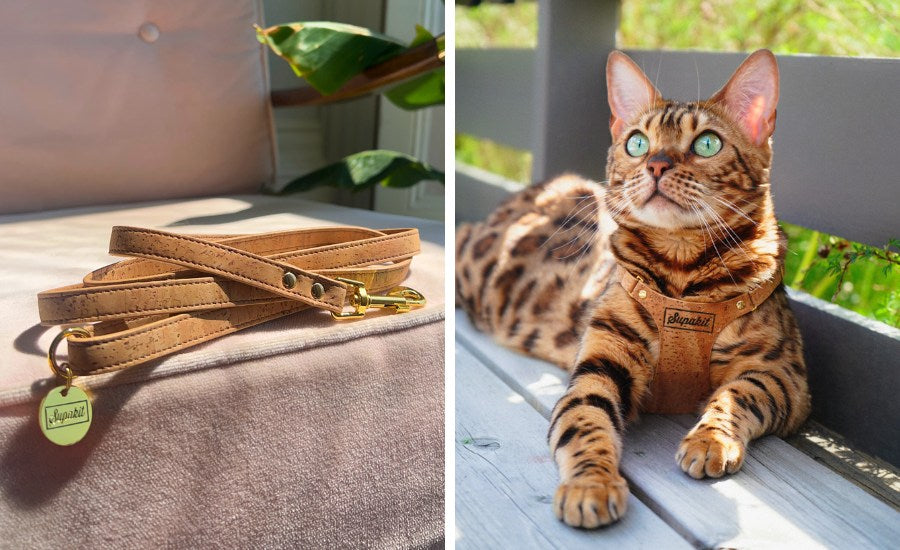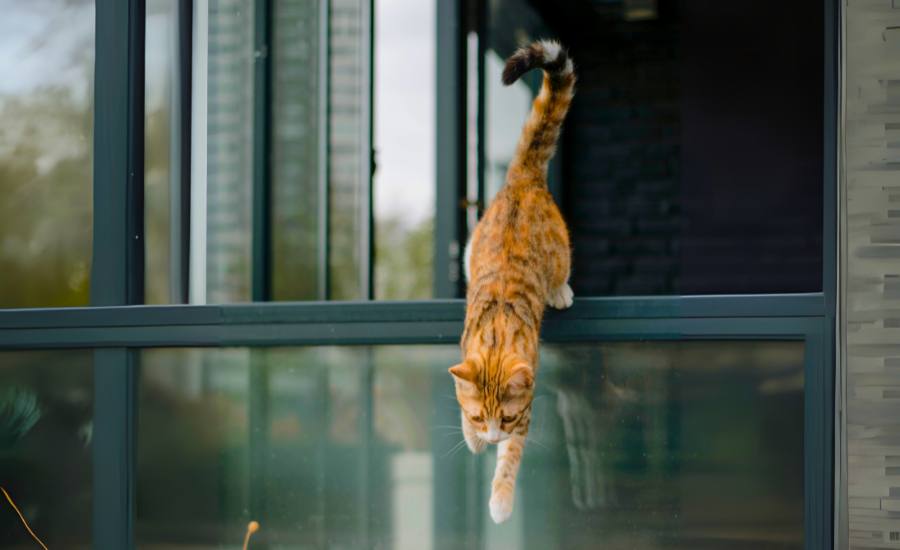Dog Encounters
Taking your cat out for a walk is a great way to provide environmental enrichment, exercise, and sensory stimulation, all whilst strengthening your bond and having fun! But one of the most commonly asked questions we get is how to navigate dogs whilst walking your cat.
We know that for many cat explorers, interactions with dogs can seem daunting (we’ve heard the not-so-great stories too!). Will your cat be scared of a dog? What happens if a dog chases your cat? How can you keep yourself and your cat safe around an off-leash dog?
Positive encounters with dogs far outweigh the negative but we know it’s always best to be prepared. In this article, we hope to help guide you through dog encounters and help you feel empowered to meet dogs out on walks with confidence, so we can all share the outdoor world in harmony!
Are cats scared of dogs?

Not all cats are scared of dogs, but cats are naturally cautious of dogs due to their size.
However, cats can be trained to be less fearful of dogs. If your cat is exposed to friendly, non-threatening dogs at an early age (e.g. if you have a family dog), this process may happen organically. Over repeated episodes of friendly contact, your cat is likely to form a positive association with dogs, and associate them with fun, not fear.
On the other hand, if your cat has no previous experience with dogs or has previously had a negative experience, they may need a little more encouragement. Desensitisation and counterconditioning, used together, are a great tool to help your cat overcome their caution or fear of dogs.
What is desensitisation?
Desensitisation is the process of exposing your cat to a stimulus that would normally cause them fear, but at such low intensity that they don’t have any reaction . An example of this could be a dog on the tv, the sound of dogs playing quietly on a device like a phone or speaker or a blanket carrying a dog’s scent (if you have a friend or family member with a dog who can help out). As your cat becomes desensitised to the stimulus, you can then gradually increase its intensity over successive training sessions (e.g. increasing the volume of the dog sounds or moving the dog-scented blanket closer). By always working below your cat’s threshold of fear, this process can help your cat become less reactive and fearful of dogs.
What is counter conditioning?
Counter conditioning is the process of changing your cat’s emotional response to a stimulus. If your cat has only ever had fearful experiences with a dog, it is likely to have developed a negative association with dogs in their mind. Counter conditioning lets us flip that into a positive association. We can add counter-conditioning into our desensitisation training program by exposing our cat to the dog-related stimulus (at a level that isn’t causing them fear), and then simultaneously delivering something they really like at the same time. Examples could be play with their favourite toy, a high-value food treat, or a form of affection that they love.
Taken together, this process of desensitisation and counter conditioning can help your cat to become less fearful of dogs, and break down any negative associations that have been formed in the past. The time this may take will vary from cat to cat.
How to prepare your cat for encountering dogs

- Safe Space training
A key component to keeping your cat safe on any outdoor adventure is to provide them with a ‘safe space’– somewhere that they can retreat to and feel totally safe and secure. The most common type of safe space is a cat backpack. We recognise cat backpack training or ‘safe space’ training as a fundamental in harness training your cat because you never know what dangers you may run into whilst walking your cat.
Related Guide: How to Harness Train Your Cat
Before you venture outdoors, make sure that your cat is completely comfortable within their portable safe space. In the event that your cat needs somewhere to retreat to quickly, you want them to go into their safe space without hesitation. If your cat shows any resistance about going into their safe space, its best to work on this training a little more before you head outside.
In the unlikely event that your cat needs to access their safe space quickly, think about how you would get them in there. In time sensitive situations, you may not have opportunity to take the backpack off, put it down on the ground and open it up. Keeping the top access to the backpack completely open, practice picking up your cat and placing them over your shoulder to guide them into their backpack. Once your cat is inside, you can give them a reward.
Training your cat to enter their backpack this way can be really helpful when you quickly need to scoop them up to keep them safe.
Related Guide: Cat Walking, Your Questions Answered!
- Cat handling / Perch training
Safe space training is a great place to start for cat adventuring but as your cat’s confidence grows, you may want to explore alternative ways that they can stay safe. As cats typically feel safer the higher they are, we can use this to our advantage and train them to be held or perch when we need them to be off the ground.
Start off by practicing lifting your cat at home – this may sound simple, but some cats really don’t enjoy being held. Practicing this allows you to work out which way your cat prefers to be held and then you can train them to be held for as long as is necessary. Start by picking your cat up and rewarding them. Gradually you can progress from holding them for a few seconds to a couple of minutes. For cats who really don’t like being lifted, you could train your cat to jump up into your arms or up onto the bag, your shoulder or arm where they can ‘perch’.
- Dog training
You might be super lucky and have a cat that has grown up with dogs, or is comfortable being around them. If not and you are fortunate enough to have a relative, friend or neighbour who has a well-behaved dog, why not ask them if they would like to help in some encounter training? Not only is this great for your cat, but it can be super helpful for the dog too!
Introducing new animals can be a delicate process so it’s best to pick a place that is safe for everyone involved and keep both animals on a leash. Have your safe space handy so your cat can retreat if they need to and bring rewards! Forming a positive association with dogs will help your cat feel more comfortable around them. Take it slowly and keep sessions short. At first, it is enough for them to be in the same room or space. They don’t have to be super close at any stage but being around one another is a great opportunity for you cat to learn that dogs aren’t scary. Keep your cat distracted and reward them for displaying positive and relaxed body language in the dog’s presence. Don’t force them to do anything they don’t want to do.
If at any point either animal is feeling really uncomfortable, frightened, or showing signs of aggression, you should stop the session and revisit it another time. If all goes well, you can build up to them being closer together and interacting with each other.
How to find cat-friendly places near you

Typically, meeting dogs out on your walks is part and parcel of walking your cat outside. But, if you want to try and minimise the risk of meeting a dog, you could start by doing a reconnaissance of any potential cat-walking spot. This is a great way for you to explore the area first, without your cat and gauge whether or not it feels like a safe place to take them. It can also be helpful to do this at different times of the day, or days of the week, as foot traffic may vary.
Another way to locate cat-friendly places is to ask your friends or the cat community! Cat walking is becoming much more mainstream, so utilise the people around you. They might be able to recommend a great place for you to go. Supakit also have a Cat Map, where users can find and add cat-friendly locations near them. With some amazing submissions, there are an abundance of tried and tested, cat-friendly places ready to be explored.
If you have any concerns about an area you think you’d like to visit, you can check the local authority guidance online. Parks, National parks, and nature reserves tend to have a pet policy. Some will state that dogs must be kept on leashes at all times. Although not everyone will observe these rules, usually it’s a good place to start.
Supakit have created a great Cat Friendly Map covering the whole world, so you can find a safe place to adventure with your cat.
Dog encounters outdoors

If you’re nervous about meeting a dog outdoors, there are some things you can do to feel more prepared. There’s nothing worse than feeling caught off-guard so one way to remedy this is to bring another person with you, and walk in a pair. With one person ahead and the cat in between, this extra pair of eyes and ears can spot a dog up ahead and give prior warning. This gives you time to pick up your cat and place it in its carrier or let it perch.
If you are a solo cat-walker, try and minimise your distractions. You want to be extra alert, so it’s best to remove headphones and put your phone away so you can focus on your cat and what’s going on around you. This will help you react more quickly if a dog approaches unexpectedly.
Make sure you always have your safe space with you too so that your cat can retreat if it needs to.
Meeting dogs out on walks is an opportunity to reinforce the positive association your cat has with them. If the dog walker is willing and their dog is safely leashed, why not stop and have a chat? Your cat can view this safely and see that dogs are nothing to be feared. You may be surprised at how often a dog won’t even notice your cat when it’s busy being fussed over! By also introducing yourself to a dog walker, you give them polite notice to they might bump into you again on another walk – it helps them be prepared too.
Related Guide: Cat Exploring for Beginners
What to do when you meet an off-leash dog

Meeting an off-leash dog is a lot of cat walkers’ biggest fear, as they tend to come out of nowhere. It is really important to try and remain calm in these situations. Most dogs are just curious and excited to see you. A cat’s natural instinct on meeting a larger animal like a dog can often be to run and hide, but this can trigger a dog’s instinct to give chase. However, by working on your cat’s confidence around dogs, you may have reached a stage where they do not run away from a dog and stand still. This vastly decreases the chances of your cat being chased.
Whatever your cat’s reaction, when an off-leash dog approaches, it is advisable to lift your cat and get them somewhere high and safe, preferably into their safe space. If the dog is happy, you can try and distract their attention. Remember, the owner probably wasn’t expecting to see a cat and although that doesn’t excuse their dog not being on a leash (if it is required), it’s a nice opportunity to introduce yourself and let them know that you and your cat will be sharing this space with them in future.
Sadly, there might be a rare occasion where you meet an aggressive dog. Again, it is really important to try and remain calm. If you can, get your cat to a safe, high place. Stand still and avoid sudden movements. Protect your arms, hands, and fingers, and deploy a strong command like ‘No!’ whilst avoiding eye contact. You can try and call for assistance. Shouting a direct question is good, such as “Is this your dog?” as it elicits a response. When the owner of the dog arrives, politely advise them that you’ll be walking your cat in this area again.
When taking your cat outside, other than their microchip, be sure to always have a collar and ID tag on them. If you find yourself in a situation where your cat is scared to the point of running away, an ID tag will increase the chances of successfully being reunited.
Related Guide: How To Keep Your Cat Happy Outside
As we continue to explore further with our cats, sharing the outdoor space is inevitable – beyond the backyard, it’s usually not possible to avoid dogs altogether. But with the right training and good preparation, it is possible to make sure your cat remains safe and happy, no matter who or what you meet on your adventures! We like to remember that every new dog encounter is an opportunity to educate our cats, and other dog owners about sharing the space outdoors, to create a more diverse, harmonious world for all pets who want to venture outside.
Related Guides:







